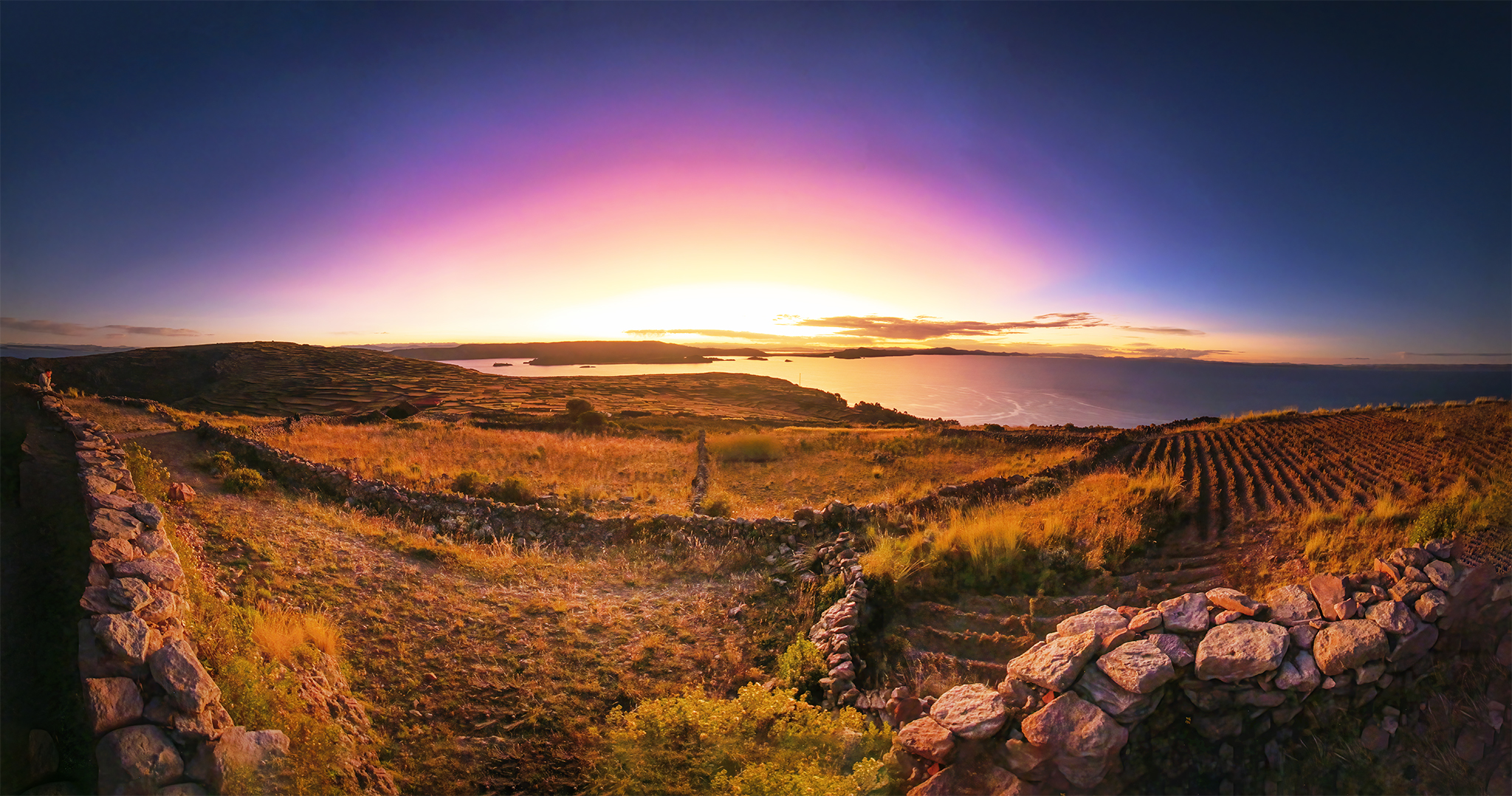Welcome to Lake Titicaca! This post covers a visit to the three main islands on the Peruvian side of the world’s highest lake, and hopes to teach you a bit about the people who live there.
Let’s kick things off with arguably the most interesting, the Uros floating islands, and their inhabitants – the Uru people.
Yeah, you read that right. Floating islands!

The Uru people live on around 120 manmade islands, constructed almost entirely out of a local reed called Totora (more on that soon). Bigger islands host as many as ten families while smaller islands host one or two.
Located at 3,800m above sea level, evening temperatures on the Uros islands often drop below 0°C in the colder months, and Uru legend holds that their people have black blood, rendering them unable to feel the cold. While I’m not sure if the legend holds up to scientific scrutiny, they certainly have an impressive tolerance for the freezing nights on Lake Titicaca.
It’s believed that the Uru originated from a pre-Inca Amazonian people who arrived on the shores of Lake Titicaca and were subject to oppression from the local people upon their arrival. Consequently, they decided to move to the middle of the lake, around 15km from the mainland (yeah, Lake Titicaca is huge). They lived there for centuries, hunting freshwater fish and local birds, and speaking their traditional language, Uru.
In 1986, a major storm devastated the Uros islands and they were subsequently rebuilt closer to the Peruvian city of Puno. Since then, tourism has become the primary source of income for the Uru, with hundreds of visitors to the islands daily. Tour boats arrive at the administrative area first and are then directed to an island with a family eagerly awaiting their arrival.
Integration and trade with the mainland are common in the modern era, however the islands still contain a number of kindergartens and primary schools, as well as a radio station and a church. The Uru today mostly speak Spanish and Aymara, another local indigenous language. Only two speakers of Uru remained in 2004, and sadly both have since been lost, along with the Uru language.

If you think that people living on floating islands is hard to believe, wait until you hear about what I think has to be up there as the world’s most versatile plant!
The Uros islands are made out of Totora, a reed that grows on Lake Titicaca and looks kinda like a gigantic spring onion, with a solid white base and a flexible green stem. The Totora grows from large, solid patches of soil which contain the Totora roots and float on the lake’s surface. The Uru harvest the reeds from large reserves by cutting the bigger patches into smaller blocks, which are then transported to the desired destination.
In order to create an island, the Uru then tie the blocks back together in the required shape, and the roots slowly re-intertwine to form a solid foundation. Finally, the reeds are sliced at the roots and placed flat on the surface of the island to form a soft, springy base to walk around on. The reeds dry out and eventually create a fire hazard, so a new layer of fresh reeds is laid roughly once a month.
But the fun doesn’t stop there with Totora. You’ll notice the guy in the red hat chowing down on the reed as well, as the white base also represents one of the main food sources on the islands. If the Uru get sick of the taste, the drier reeds are used as kindling for cooking freshwater fish from the lake. Totora flowers can be used to make tea, and with their high levels of iodine, the reeds can also be used as a toothbrush! When the Uru experience pain, the reeds are wrapped around the affected body part, and the white base can be broken up and placed on the forehead to relieve fevers.
Finally, the Uru utilise Totora to create all manner of day-to-day objects – from houses and boats, to items of clothing and trinkets which are sold to tourists.
Totora is a truly remarkable piece of Peruvian flora, and the Uru have managed to master it with incredible ingenuity.

Without the constant distractions of modern, Western society, the kids on the Uros floating islands all seemed so genuinely happy and content with the smallest of pleasures. This little munchkin (who will henceforth be referred to as Munchkin as I can’t remember his name) spent well over an hour enjoying a paper airplane, throwing it back and forth with any tourist willing to spare the time.
Shortly after taking this photo, we hopped on a rowboat for a journey to another island. Naturally, Munchkin brought his airplane along and continued tossing it to myself and another guy on the boat. This went on for several minutes until the unthinkable happened. Munchkin put a little too much muscle onto one of his throws, the plane sailed over our heads and nosedived into the lake. We turned back to look at Munchkin with apprehension, unsure whether he would dive into the lake to retrieve it, or simply burst into tears.
Instead, a beaming smile spread across his face. He thrust both hands in the air and screamed, “YEAAAHHH!” (or whatever the equivalent is in Aymara)
Turns out this is what he’d been trying to do all along, and he was thrilled at having finally conquered the hapless tourists.

One common theme I’ve noticed in Peru, particularly in the more rural areas, is that most of the manual labour tends to fall to women. Women are the ones most often working the fields, tending to livestock, or in this case rowing boats, and it’s not uncommon to see women walking for miles with huge loads strapped to their backs. All this is not to mention that household duties like cooking and childcare also fall almost exclusively to women.
Indeed, one analysis found that the average rural woman in Peru accounts for 80% of her family’s labour force. Despite this, the upper levels of Peruvian society remain strongly patriarchal, with participation of women in parliament currently around 26%, even though quotas exist that demand 30%.
Things get worse when reproductive health is considered. Access to contraception does not cover demand, and consequently more than a third of pregnancies end in abortion. Peru also has one of the highest maternal death rates in South America, and all of these challenges disproportionately impact rural, indigenous women.
By far the worst example of this discrimination came in the form of former president Alberto Fujimori’s forced sterilisation campaigns. Between 1996 and 2001, more than 270,000 Peruvian women – almost exclusively from rural, indigenous backgrounds – were sterilised, and a significant number of these sterilisations occurred without consent or proper understanding of the procedure.
Fujimori’s actions are today widely regarded as a violation of human rights, a campaign of ethnic cleansing, and even genocide. However, the program received financial support from America, Japan and the United Nations at the time.
Women’s rights in Peru have certainly come a long way since this dark period, but it is also clear that they still have a long way to go.

Following the Uros floating islands, the next stop on our tour of Lake Titicaca was Amantaní. This stunning island is located around 40km from the city of Puno, and is home to around 3,600 residents. Interestingly, the inhabitants of Amantaní (and Taquile, which we’ll get to tomorrow) all speak Quechua, the language of the Inca, despite almost all the other communities around the lake speaking Aymara.
The Amantaní community is heavily reliant on tourism and many families open up their houses to tourists for cultural immersion experiences. I had the privilege of spending a night with a family on Amantaní who cooked us a delicious lunch before we were given the chance to hike to either of Amantaní’s two peaks – Pachamama (‘Mother Earth’) and Pachatata (‘Father Earth’), with ancient ruins located atop each. We decided to go for Pachatata, as it had amazing views of the sunset and is the highest point on the island at a whopping 4,150m above sea level.
After hiking back down we had a quick dinner before being dressed up in traditional clothing and taken to the dance hall. A local band was playing and we were soon incorporated into the island’s unique dance style. It was essentially just holding hands in a big circle and moving into the centre and back again, and it was a ridiculously fun night.
The people of Amantaní island were the most hospitable and generous I’ve encountered on my travels, and the homestay was one of my favourite experiences so far (the family also had two newborn kittens which pretty much sealed the deal).

After spending the night on Amantaní island, we headed early the next morning to neighbouring Taquile island. Slightly smaller than Amantaní, Taquile is home to around 2,200 residents, known as Taquileños!
The Taquileños run a collectivist community grounded by an ancient Inca moral code: ama sua, ama llulla, ama qhilla. “Do not steal, do not lie, do not be lazy.” Tourism is the primary source of income and an administrative council directs guests to houses and restaurants evenly to ensure a fair distribution of opportunity. A similar method defines the agricultural system on the island, wherein benefits from fishing, livestock and farming are divided fairly amongst the population.

Perhaps the standout feature of the island of Taquile’s community is its handwoven textiles and clothing, considered amongst the best quality in all of Peru. While the wool may be spun and coloured by the women, the knitting is exclusively performed by Taquile’s men, who learn the skill from a very young age and perform their craft with great pride.
Marital traditions on Taquile are also extremely unique. Men wear different coloured hats to signify if they are single, dating, or married. The dating phase of a relationship on Taquile lasts exactly two years, at which point the couple must decide whether they wish to marry. This is a highly important decision, because divorce is essentially outlawed in the community, and can result in banishment from the island. If a woman decides to take that leap of faith, she professes her love by weaving her husband-to-be a wide belt with two layers. The outer layer she designs herself and is typically brightly coloured, while the inner layer is created by weaving together hair from the other women in the community, who donate their precious locks as a sign of support to the new couple.
The indigenous communities who inhabit the islands of Lake Titicaca represent a rich, welcoming and diverse set of cultures that are a privilege to be invited to experience. Above all, they all seem to have perfectly navigated the hazards of the modern world, taking what they need from tourism to supplement their needs, and yet still living wonderfully simple, community-focused lives.


